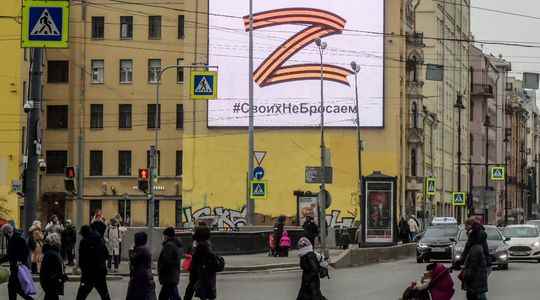He had intrigued in the early days of the war in Ukraine. And generated its share of theory. A “Z” – from the Latin alphabet and not Cyrillic -, observed on Russian tanks and trucks on their way to the invasion of Ukraine. A letter painted in white, clearly visible on the khaki and brown of the vehicles, the meaning of which has not yet been formally determined. Even the experts can’t agree on the subject. Except to agree that even without clarification from Moscow, this sign has become, over the days, a symbol of support for the Russian army.
Attempts to explain this “Z” are however not lacking. Some argue, very prosaically, that it would be a military code to differentiate the various Russian units on the ground. In other Ukrainian regions, “V” and “O” appear on the tanks.
Or, still in bellicose tactics, that this letter would make it possible to distinguish Russian and Ukrainian armored vehicles which look rather similar. A way to avoid friendly fire. In Russian, “zapad” also means “west”: the “Z” could therefore designate the armed forces of the western part of the country, those who were posted on the Ukrainian border for many weeks before the start of the invasion.
The Russian authorities did not explain the meaning of the letter, which intrigues and flourishes on social networks. They preferred to transform the “Z” into communication and propaganda tools. In recent days, on its Instagram and Telegram pages, the Russian Ministry of Defense has declined it in several messages: “Za Pobedu” (“For victory”), “Za Mir” (“For peace”), “Za pravdu” (“For the truth”), “Za Rossiïou” (“For Russia”).
Another post mentioned the term “DemilitariZation” (in English in the text), a lexicon widely used by Vladimir Putin since the start of the conflict to justify sending Russian troops to his neighbor. Nothing, however, concerning Ukrainian President Volodymyr Zelensky. Its name beginning with the letter “Z”, some conjectured a clear objective and marked by the Russians.
A Russian athlete displays it on a podium
The letter has since spread among the population. Citizens draw “Z” on cars, embroider it on their clothes, taxis display it on their vehicles with Russian flags hanging from the windows. Others post photos, videos on social networks or wear them on Russian television to show their support for the army.
Local media also published a photo taken from the sky of about sixty sick children, their families and caregivers, forming a “Z” in the snowy courtyard of their hospice located in Kazan, Tatarstan. Last weekend, during the World Cup in Doha (Qatar), the Russian gymnast Ivan Kuliak also displayed it on his outfit when climbing on the third step of the podium. At his side, the first of the competition: Ilia Kovtun, a Ukrainian athlete…
The International Gymnastics Federation has since called for “the opening of disciplinary proceedings against Kuliak for his shocking behavior”. The young athlete, supported by the president of the Russian federation, for his part declared to the media of his country that if he had to do it again, he would do “the same thing”. “I saw it worn by our military and looked at what the symbol meant. […] I wanted to show my position. As an athlete, I will always fight for victory and play for peace,” he said.
The RT channel, owned by Moscow and banned from broadcasting in the European Union since March 2, sniffed out the vein: it launched into the sale of flocked “Z” T-shirts. “All proceeds from sales will go to refugees from Donbass and the heroes of RT’s project ‘Children of War’,” the media outlet wrote on its website.
